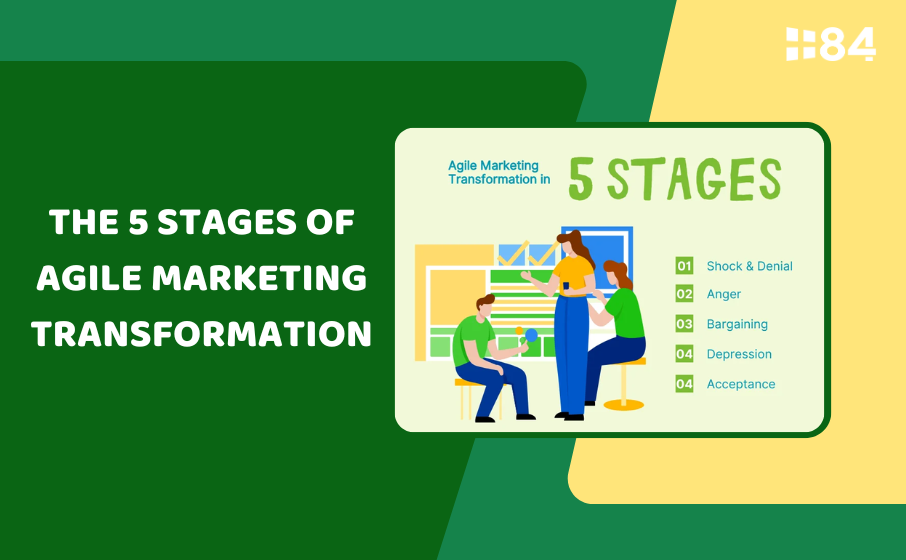When it comes to Agile Marketing transformation, there’s no denying that it’s a journey filled with change and challenges—demanding flexibility and a willingness to adapt from every member of the organization. Agile Marketing is not just about adopting a new workflow; it’s a philosophy, an innovative approach that helps businesses adapt more effectively to a rapidly changing environment and develop more impactful strategies.
However, achieving this transformation isn’t always easy—it requires patience and an open mindset toward change. To make the transition smoother, you need to begin by understanding what might happen along the way and how you and your team can respond.
That’s why we’ve broken down the Agile Marketing transformation into five stages using the classic Kübler-Ross Change Curve (which describes denial, anger, bargaining, depression, and acceptance). This model helps us understand how people typically react to major changes and how those reactions can impact team performance.
Through this article, you’ll gain insights into what to expect and how to guide your team through each challenging phase more effectively. The key is not to fear the challenges but to embrace them as opportunities for growth—both individually and organizationally.
STAGE 1: SHOCK AND DENIAL
Agile Marketing can represent a significant shift for many team members, so it’s no surprise that some may initially resist the change. Traditionally, planning several months in advance brings a sense of control and comfort—even if it slows things down or reduces efficiency.
Interestingly, in this early stage, there may be a temporary uptick in productivity and engagement. That’s because team members often band together to resist the change, becoming more proactive and focused as they attempt to demonstrate that their current methods still work.
You might hear concerns like, “So, we’re not planning anymore?” from those unfamiliar with Agile Marketing. Of course, that’s not how Agile works, but it’s a natural reaction for those new to the concept.
That’s why gaining buy-in from the entire team—especially early on—is essential for any Agile Marketing transformation. For most people, training and coaching are the most effective ways to build understanding and support.
STAGE 2: ANGER
As the transformation progresses, some team members may move into the anger phase. Feelings of frustration and loss of control over how things are changing can lead to tension within the team.
At this stage, it’s crucial to emphasize the increased autonomy that Agile Marketing offers. In an Agile environment, marketers no longer have to rely on others to set their priorities. While some may initially feel upset or frustrated, the goal of these changes is to empower them with more ownership and decision-making capability.
It’s also worth noting that strictly following a single Agile framework may not work for everyone. Often, tailoring the Agile approach to the specific needs of your team leads to better outcomes. If team members feel that the Agile implementation doesn’t fit their workflow, work with them to create a more flexible system that allows for greater freedom and effectiveness.
STAGE 3: BARGAINING
By this stage, the initial resistance has likely subsided, and ideally, your team has gone through training, received coaching, or even developed its own custom Agile framework. Still, some may feel uncertain. At this point, resistance often shifts into bargaining—looking for the path of least resistance. You might hear things like, “Okay, I’ll use the Kanban board, but I’d rather skip the daily standups.”
While hybrid approaches to Agile Marketing can be beneficial, selective adoption—where each team member only embraces parts of the methodology—may not yield strong results. It can lead to inconsistency, reduced performance, and misalignment. To fully unlock the benefits of Agile Marketing, your team must commit to Agile not just as a set of tools, but as a mindset and operating model.
As the saying goes: “Part-time Agile pilots do not work.” If the team isn’t fully committed, the transformation is unlikely to succeed. Every member must contribute consistently and wholeheartedly throughout the Agile implementation.

If you find yourself in a negotiation with stakeholders or team members, make sure you’re bargaining within the Agile space. Combining two Agile methodologies can work; mixing Agile with non-Agile processes generally does not. Focus on finding the right Agile approach for your team during this phase—this is your best shot at long-term success.
STAGE 4: DEPRESSION
At this point, those who are still hesitant realize that Agile is here to stay—whether they like it or not—and may enter a stage of disengagement or even quiet resignation. They may comply on the surface, going through the motions to avoid management scrutiny, but they aren’t fully invested.
The result is that they miss out on the real benefits Agile can bring. The challenge here is helping team members personally experience the value of Agile. When individuals see how Agile improves their own work, they are far more likely to embrace it.
Framing the Agile transformation as an opportunity to improve how the organization works as a whole can be especially impactful. Agile often originates in software development, so when marketing or sales adopts it successfully, other departments often follow. Remind your team that their efforts could become a benchmark that others look to for inspiration and guidance.
STAGE 5: ACCEPTANCE
Finally—success! This is when your marketing team members begin to see the tangible benefits of Agile for themselves. It’s time to reflect on what worked, what didn’t, and how to continue applying Agile Marketing principles moving forward.
This stage is also when other departments in your organization may start asking how your team made it work. When this happens, it’s helpful to create opportunities for those in Stage 5 to connect with teams still stuck in earlier phases—especially the depression stage. Seeing firsthand the benefits of Agile can inspire and motivate others to push forward.
GETTING TO STAGE 5 AS EARLY AS POSSIBLE
Remember: Agile cannot thrive without psychological safety. Team members need to trust one another to truly be flexible and autonomous. Going through these stages—though challenging—is essential to building genuine commitment and trust within the team.
Above all, throughout all five stages, you must be patient, lead by example, and demonstrate genuine belief in Agile. Your team needs to see that Agile is not something being imposed on them—it’s something you truly believe will make everyone’s work better. To guide your team through the tough phases of Agile Marketing transformation, strong leadership, structured training, and hands-on coaching are your most effective tools.
In summary, the shift to Agile Marketing is a bold and transformative journey—one that requires adaptability and a willingness to change from everyone in the organization. While it brings its share of challenges, with patience and strong leadership, each stage can be successfully navigated. Adopting Agile Marketing is not just about changing how work is done—it’s about embracing a new approach that opens up opportunities for growth and innovation.
By creating a flexible, empowered, and collaborative environment, you lay the foundation for long-term success in Agile Marketing. With the insights and knowledge from this article, you can guide your team through this transformation with strength and clarity. Support them, listen to them, and continuously encourage the application of Agile practices in everyday work. In doing so, you’ll build a resilient, adaptive organization poised to thrive in today’s fast-paced business world.


